Mary Anne Yarde's Blog: The Coffee Pot Book Club , page 179
April 22, 2018
Book Spotlight ~ Pantheon by Christopher Lee #SciFi #ScienceFiction #Mythology @ChristLeeEich
PantheonBy Christopher Lee

A dark epic space fantasy casting the gods, goddesses, and heroes of ancient mythology. The Norse, Greek, Egyptian, and Celtic Pantheons square off in a battle royale for the Celestial Throne as mankind's mightiest heroes defend against the coming tide of blood and darkness. History really does repeat itself. Relive the ancient myths and legends of human history in a futuristic setting beyond anything you've read before.
Exclusively on Patreon
Christopher Lee
 Christopher Lee is the author of the Hallowed Veil Series, an epic fantasy series that spans the breadth of human history. Christopher is an avid history buff, mythologist, bardic poet, and keeper of the old ways. Though Nemeton is his first published release, Christopher is hard at work bringing the subsequent chapters of the Hallowed Veil Series to life.
Christopher Lee is the author of the Hallowed Veil Series, an epic fantasy series that spans the breadth of human history. Christopher is an avid history buff, mythologist, bardic poet, and keeper of the old ways. Though Nemeton is his first published release, Christopher is hard at work bringing the subsequent chapters of the Hallowed Veil Series to life.Christopher loves to hear from readers, you an find him: Website Facebook Instagram Twitter
Published on April 22, 2018 23:00
April 20, 2018
#Bookreview ~ (Untamed Regency Book 3) by Jackie Williams #Regency #Romance #mustread @wackyjackyful
A Ring of Midnight Orchids:Flowers of the Aristocracy (Untamed Regency Book 3) By Jackie Williams
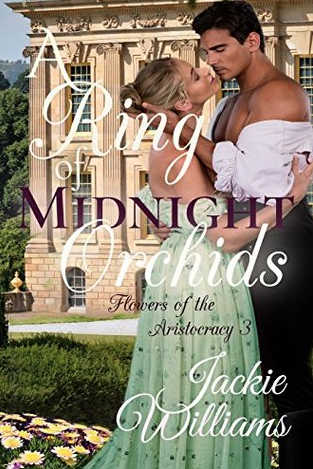
Who would have believed it? His lifelong friend, Lord Pierce Trenchard engaged! To none other than the lovely, but frivolous Angelique Lancer. As if hurt pride, a broken nose, and crushed hopes were not enough, the surprise announcement in the London paper almost made Lord Lucas Caruthers choke on his breakfast.
Lovely she may be, but marriage to a woman who prefers to peruse books rather than follow the hunt? Not in Pierce’s lifetime! However, with essential body parts under threat of imminent amputation, what other options does a man have? None. The Peckham Pulveriser, a notorious cheating prizefighter, breaker of the Caruthers noble nose, and brother of Angelique, is not a man one can reason with... Unless Pierce can perhaps persuade someone else to do the dreaded deed! A visit to his most stalwart friend, the recently jilted Lucas Caruthers, is clearly in order.
Lucas could barely believe his own ears! Friends they might be, but marrying his archrival’s sister was stretching the boundaries too far. Although the suggestion did throw up certain ideas. Could Pierce’s ill fortune be Lucas’ salvation? A chance to seek retribution for his own pain and ruined looks, while saving his friend from a parson’s noose? It certainly seemed an opportunity not to be missed.
But the truth about Angelique is not quite what Lucas has been led to believe. His quest for revenge reveals depths he would never have imagined, and while Pierce disappears into hiding, Lucas’ is left with the delightful tilt of a stubborn chin, a pair of deliciously determined shoulders, and the heady fragrance of Midnight Orchids playing on his mind.
And this time he concedes that, if the Pulveriser wants to fight it out, it might not be simply the Caruthers nose that is broken.
The Coffee Pot Book Club Review

There is always that one friend you would do anything for. When Lord Pierce Trenchard comes knocking on Lord Lucas Caruthers door with a plea to help him escape from his impending marriage, what else could Lucas do but help him escape the parson's noose?
But what Lucas did not take into account was Lord Pierce's betrothal. He had heard of Angelique, of course. She was considered shy and had a nose constantly stuck in a book. However, there was another side to her. A side that only Lucas had seen. And it was a side of her he would very much like to know a little better...
I have really enjoyed Jackie Williams Untamed Regency series. When I heard that a new book had been released, I could not wait to get my hands on it. A Ring of Midnight Orchids: Flowers of the Aristocracy (Untamed Regency Book 3) is a tender, emotional, hysterically funny story that grabbed me from the first sentence and kept me hooked throughout the rest of the book.
I adored the characterisation of Angelique. There is so much more to her character than the shy violet that the ton gossips about. Lucas is so different to any man she has ever met. He is tender, and loving, and kind. It is no wonder she falls for him. Likewise, Lucas is a real sweetheart. A very gentle man who, despite being a prize-fighter, feels everything with his heart. He wants to give Angelique — his Angel — everything that has been denied her.
As well as being a great romance, this is one of those books where you will find yourself laughing out loud. I am not going to give away any spoilers, but there is scene which was so brilliantly executed that I am still laughing now!
Book 4 of this series cannot come fast enough. Love. Love. Love it!
Amazon US Amazon UK
Jackie Williams
 I was born in Essex England during the mid sixties but I missed all the fun. Being only young, I assumed that all Beatles were six legged creatures and Flower Power was something to do with the vigorous way my mother kneaded the bread dough.
I was born in Essex England during the mid sixties but I missed all the fun. Being only young, I assumed that all Beatles were six legged creatures and Flower Power was something to do with the vigorous way my mother kneaded the bread dough.My wonderful parents brought me up with a huge love of books. We read anything and everything. Bedtime stories were a treasured time of adventure and mystery. My sister and I sat wide eyed in wonder and to this day I worry about Dinah and Dorinda being pricked with pins because they grew so fat, and I never pull faces at the a waning moon (or was it a waxing one?) just in case my chops stay that way . (The Wind On The Moon)
I began reading romance while still at school. The fuel for many a teenage fantasy leapt from between the covers of wildly romantic books and my passion still lingers now for all those dark haired heroes.
My own beautiful teenage daughter persuaded me to write my first romance. She was only fourteen at the time and between books for children and adults. She couldn't find anything that ticked all her numerous and particular boxes and so she asked me to write a book, with all the exact ingredients just for her. Though not just a book for teens, she enjoyed the resulting tale so much that she shared it with her friends and I eventually published A Perfect Summer as an ebook on amazon.
But I have discovered that writing is not easily stopped once you start. It has turned into a grand passion that I just cannot hold back. The fingertips start tapping the keys and ideas suddenly come flooding, far too many for just one book and so I began another and then another, and I am still nowhere near done.
I hope you enjoy all of my efforts and I look forward to your comments and reviews.
If you are interested in finding out more, you can see what I get up to at:
Romance Suspense Books
Don’t forget to sign up to my newsletter for all my latest goings on:
Newsletter
You can find me on Wordpress, Twitter, Facebook, Google+, Pinterest, and Instagram.
Published on April 20, 2018 09:05
Life in the time of Mordred Pendragon by Mary Anne Yarde #Arthurian #Legend #KingArthur
Life in the time of Mordred Pendragon
By Mary Anne Yarde

Jesus wasn't betrayed by an enemy. He was betrayed by a friend. As was King Arthur. That is how the story goes anyway.
Mordred, the noblest of knights, betrayed his King and in doing so, he brought down a kingdom. But that is not all. Mordred was not just a Knight of Camelot. He was of royal blood.
Mordred was the son of Morgause - Arthur's sister - but there is debate as to who his father was. Some say his father was Morgauses' husband, King Lot of Orkney, which would make Gawain his brother. While others say he was Arthur's illegitimate son, begot with his sister. Either way, he had royal blood running in his veins. Of all the Knights in Arthur's court, Mordred was beyond suspicion. So how did Arthur and Mordred find themselves leading opposing armies on that fateful day in Camlann?
The earliest known reference to the Battle of Camlann can be found in the Annales Cambriae. The Annales of Cambriae is a chronicle that dates back to the 10th Century. It was compelled sometime between 960 - 970AD in Dyfed, Wales. The Annales Cambriae dates the Battle of Camlann in the year 537 AD. And this is what it says...
"The strife of Camlann, in which Arthur and Medraut fell."
Although they cannot be counted as a primary source, they do however draw on older stories - probably verbal - of the telling of this great battle. If you have not already noticed, the quote above says nothing about Arthur fighting Mordred at Camlann. It states that both men fell (died) at Camlann. Mordred was one of Arthur's most loyal knights, therefore it would make sense that they died together because they fought together. Which begs the question, how did Mordred become the villain of the tale?
 Sir Mordred by H. J. Ford (1902)
Sir Mordred by H. J. Ford (1902)In 1136, Geoffrey of Monmouth penned The History of the Kings of Britain. It is Monmouth who suggests that it was Mordred, who was left in charge of Camelot while Arthur crossed the channel to rage war on Emperor Lucius of Rome. It is Monmouth who states that Mordred saw this as an opportunity to take Arthur's throne. It is Monmouth who states that Mordred not only took the kingdom but also forced Guinevere to marry him. It is Monmouth who states that Mordred and Arthur met at Camlann.
And we believed him.
The ancient Welsh texts were the first to associate Mordred with Camlann. But Monmouth's casting of Mordred as the villain was soon accepted as the truth and others expanded upon this story making Mordred something of an Anti-Christ - or an Anti-Arthur.

Time passes, and the story changes. Lancelot enters the tale, and some of Mordred's villainous activities are passed on to Lancelot - such as the affair with Guinevere.
Thomas Malory who penned Le Morte d'Arthur sticks with tradition and casts Mordred as the villain but this time there is a slight twist to the tale. In Malory's version, Mordred believes that Arthur is dead, slain by Lancelot. Mordred, with parliaments consent, is crowned King and when he hears that Arthur is alive he does take his army to meet him. But this begs the question, why would the Knights follow Mordred instead of Arthur. Malory gives us a clue..
"...with Arthur was none other life but war and strife, and with Sir Mordred was great joy and bliss."
An interesting idea indeed.
In the Lancelot-Grail Cycle, Mordred is succeeded by his sons. The sons, like their father, had treachery running through their veins. In the older text, it is Constantine who tracks the brothers down and kills them. In later versions, it is Lancelot and Bors.
But the extent of Mordred's treachery does not end there.
“I can't ignore what I saw. Gaius, Mordred is destined to play a part in Arthur's death.”BBC adaptation of Merlin 2008 - 2012
Mordred is cast as a magically Druid boy in the BBC show Merlin (2008 - 2012). He becomes a Knight of Camelot and has no notion of treachery until his beloved is sentenced to death. Ironically, if Merlin had accepted Mordred as a source of good, then Arthur would never have died - but hey, what kind of story would that have made?
Mordred became the villain, but maybe he was not so evil as we have been led to believe.
Mary Anne Yarde
 Mary Anne Yarde is the multi award-winning author of the International Bestselling Series — The Du Lac Chronicles. Set a generation after the fall of King Arthur, The Du Lac Chronicles takes you on a journey through Dark Age Briton and Brittany, where you will meet new friends and terrifying foes. Based on legends and historical fact, The Du Lac Chronicles is a series not to be missed.
Mary Anne Yarde is the multi award-winning author of the International Bestselling Series — The Du Lac Chronicles. Set a generation after the fall of King Arthur, The Du Lac Chronicles takes you on a journey through Dark Age Briton and Brittany, where you will meet new friends and terrifying foes. Based on legends and historical fact, The Du Lac Chronicles is a series not to be missed.Born in Bath, England, Mary Anne Yarde grew up in the southwest of England, surrounded and influenced by centuries of history and mythology. Glastonbury — the fabled Isle of Avalon — was a mere fifteen-minute drive from her home, and tales of King Arthur and his knights were part of her childhood.
Mary loves to hear from readers, you can find her well, here! You can also find her on Twitter and Facebook
War is coming…
Read the series for FREE on Kindle Unlimited

Amazon US Amazon UK
Published on April 20, 2018 00:30
April 18, 2018
Myths, Legends & Folklore — The Magic of Mermaids #myths #Legends @AmyBearce
The Magic of MermaidsByAmy Bearce

Of all the mythical creatures of the world, mermaids were the first to capture my heart. Whatever you call them—mermaids, merfolk, mer-people, or fin folk―these graceful sea creatures with the upper body of a human and the tail of a fish beguiled my imagination from an early age, just as they have fascinated people all over the globe throughout history.
Mermaids are a great source of inspiration for writing, as there’s such a wide variety of them in folklore. Art from ancient Assyria shows beings that appear half-human and half-fish, displayed in the Louvre. The One Thousand and One Nights collection of stories includes sea people who look like humans but live underwater. Another European folklore similar to a mermaid is the Melusine, with two fish tails that might remind you of a Starbucks cup. A Russian print from 1866 shows a mermaid and merman.

Mermaids were sometimes seen as ill omens, offering warnings or causing disasters. Most people are familiar with sirens, those seductive mermaids who lure sailors with their voices, only to drown them and their ship. But it isn’t just mermaids to watch out for, either—mermen can be dangerous, too. The Blue Men of Minch are Scottish versions of mermen with blue-tinted skin and beards, sometimes called storm kelpies. They live off the coast and challenge ship captains to a rhyming contest. If you’re witty enough, the Blue Men of Minch will allow you and you crew to live (I’d be toast.) If you have some ale, be sure to pour some in the water to please them during Samhain.
I’ve never been to Japan, but I wouldn’t want to run into any kappawhile I was there. These legendary beings enjoy playing games with humans in which the penalty for losing is death. Survival tip: if you see one on land, be aware that the top, flat part of their head needs to remain wet. If it dries out, they lose their power and might even die. They also apparently like cucumbers, so keep one on hand to throw into the water to make them happy.
Modern pop culture has its share of mermaids, too. In 1984, the movie Splash! With Daryl Hannah and Tom Hanks made me wish I could be a mermaid. A town nearby had a water theme park called Aquarena Springs where women dressed up as mermaids performed in underwater shows, drinking Dr. Pepper from a glass bottle and performing tumbles and spins. They made me hold my breath in delight. I used to pretend I had a tail in the pool, but these days, girls have a much easier time of it than I did, with fancy fins for swimming already made for them. Aquarena Springs shut down years ago, but that same town holds an annual mermaid festival now, complete with a mermaid parade. My daughter’s generation also has the TV show H2O: Just Add Water, featuring mermaids. I watched the whole series with my tween, and enjoyed it just as much as she did (or more.)

It was only to be expected then, that when I began writing fantasy, it wouldn’t take long for merfolk to appear in my stories. Mer-Charmer, book two in the World of Aluvia, focuses on merfolk, and we spend much of the story underwater with them. While I read up on mermaid folklore before writing, I wanted my merfolk to have some distinctive features.
In my world, the magical creatures are suffering from a lack of magic. While Aluvia’s merfolk are human-like and very intelligent, they also are very much adapted to their world the way deep-sea creatures on Earth are. My merfolk have bioluminescent skin they can control to light their way in the dark waters, as well as neck gills and eyes designed for underwater living. Their magic allows humans to join a merfolk under the sea without drowning. Tattoos appear on their skin from the sea’s magic during their coming-of-age ceremony, in a pattern unique to each merfolk. While they rarely cry, a merfolk’s tear holds tremendous magical power, as my human characters soon learn.

Best suited for grades 5th-8th.
Cover by Amalia Chitulescu
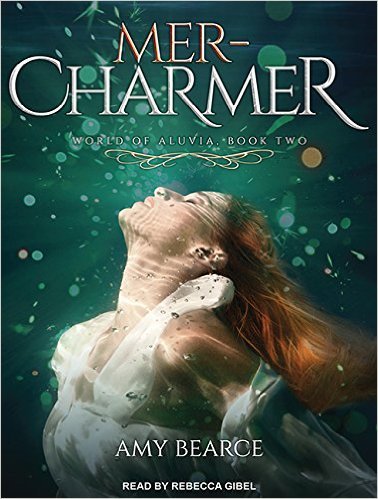
Of course, mermaids appear in stories by a wide variety of authors. The most well-known mermaid in literature could arguably be Hans Christian Anderson’s “Little Mermaid,” long before Disney got its mitts on the story. This tale of love and heartbreak made me a fairy tale fan for life. When we visited Copenhagen, I was thrilled to see the statue honoring Anderson’s most famous creation.

Me, delighting in the Little Mermaid statue in Copenhagen
Thankfully, stories about mermaids have continued to flourish since the time of Hans Christian Anderson. Check out some of these mermaid tales from modern writers, along with Mer-Charmer.
For elementary age:
The Mermaid, by Jan Brett. Jan Brett is one of the queens of children’s pictures books, author of The Mitten, The Hat, Annie and the Wild Animals, and many, many more—to include, apparently, an underwater retelling of Goldilocks. (*Runs to buy it immediately!)
The Mermaid and the Shoe , by K.G. Campbell. Little Minnow is great at asking questions…for grades 1-4.
The Tail of Emily Windsnap Liz Kessler. A great middle grade series about an ordinary girl who discovers that when she goes in water, she becomes a mermaid with many adventures. 3rd-6th.
For 6th graders and up:
Real Mermaids Don’t Wear Toe Rings (Real Mermaids series)
by Helene Boudreau. A cute book with humor, appropriate for younger teens.
Deep Blue (Waterfire Saga),
by Jennifer Donnelly.
One of the most beautiful mermaid covers out there, which is saying something.
Considered YA and upper middle grade.

Young Adult
The Siren , by Keira Cass. A poignant stand alone with dark edges and beautiful imagery.
Of Poseidon (The Syrena Legacy) by Anna Banks. A mermaid story with star-crossed lovers.
Updrift ( The Mer Chronicles) by Errin M Stevens. A romantic siren story.
Fans of mermaid mythology will find plenty of love in all the awesome options available today. What is your favorite mermaid story? I’d love to hear about it in the comments! Amy
Amy Bearce

Amy writes fantasy for tweens and teens. She is a former reading and English teacher with a Masters in Library Science. Prior to writing novels, she spent ten years writing short stories, articles, and poetry for state standardized reading tests on a freelance basis.
As an Army kid, she moved eight times before she was eighteen, so she feels especially fortunate to be married to her high school sweetheart. Together they’re raising two daughters in Texas. A perfect day for Amy involves rain pattering on the windows, popcorn, and every member of her family curled up in one cozy room reading a good book.
Amy loves to hear from readers, you can find her on... Website Twitter Instagram Facebook Goodreads
World of Aluvia series
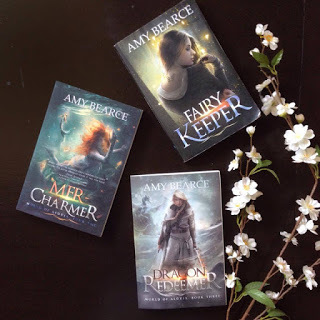
The world of Aluvia is a place of magic, but it’s a broken, dark world where magical creatures are suffering, and the land itself begins to shake apart. When the fairy queens disappear and their little fairies die, it marks the beginning of a long journey for three girls who seek to heal their world.
Sierra hates her calling as a fairy keeper, but is compelled to travel to the dangerous wilderness to find the lost queens. (Book One, Fairy Keeper)
Phoebe must help the gentle merfolk reclaim their magic once more—by first discovering her own. (Book Two, Mer-Charmer)
And Nell must hold the line when a new enemy arrives who wants to return Aluvia to the days when humans held all the power, risking the very magic they’ve worked so hard to restore. (Book Three, Dragon Redeemer)
Amazon B&N
Published on April 18, 2018 23:00
April 17, 2018
Author’s Inspiration by Eric Schumacher #amwriting #Vikings #History @DarkAgeScribe
Author’s Inspiration by Eric Schumacher
 Håkon den Gode og bøndene ved blotet på Mære by Peter Nicolai Arbo (1860)
Håkon den Gode og bøndene ved blotet på Mære by Peter Nicolai Arbo (1860)I write about Vikings. Which doesn’t sound all that crazy until you consider that I was born and raised in Southern California.
So why Vikings? The truth is, I’ve been fascinated with them since I was young. Tolkien and Dungeons and Dragons (a board game) sparked my imagination. History books, historical fiction authors, sagas, and then, movies, did the rest.
I have now completed two novels -- GOD’S HAMMER and its sequel, RAVEN’S FEAST -- and am working on a third, which is coming soon. The novels tell the story of a little known historical figure, Hakon Haraldsson, and his fight to win and keep the throne of the North (it wasn’t called Norway back then).
Hakon was the youngest son (and bastard child) of arguably one of the North’s greatest kings, Harald Fairhair. When Hakon was roughly eight years old, Harald shipped him off to England to be raised in the Christian courts of Wessex. There, he adopted Christianity and presumably learned something of the Wessex way of governing a kingdom.
 Harald Fairhair, in an illustration from the 14th century Flateyjarbók.
Harald Fairhair, in an illustration from the 14th century Flateyjarbók.At fourteen years of age, he was summoned back to the North by nobles who wanted to oust Harald’s unpopular son Erik “Bloodaxe” from the throne. Erik was a rather unsavory king, who, according to the sagas, killed off three of his brothers to make himself the most powerful king in the North. Ousting him will be a daunting task for the young Christian Hakon, but one he must undertake.
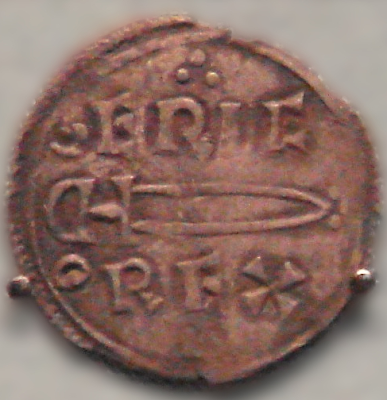 Coin of Eric Bloodaxe. The legend reads "ERIC REX" (King Eric)
Coin of Eric Bloodaxe. The legend reads "ERIC REX" (King Eric)So, what was it about Hakon and his story I found so intriguing? After all, he was not the type of person I originally envisioned myself writing about. He was not a Boromir (for you Tolkien fans) or a Beowulf. Or a well-known king, such as Harald Fairhair. On the surface, he seems pretty obscure.
But consider this: would you have a nerve to venture into a country as a fourteen year old boy to take on its brute of a king, all the while clinging to a religion that could get your killed at any moment?
That was intriguing enough for me; but there is more to Hakon’s story. His character takes many of the norms of Viking literature and turns them on their head; and his reign, which is marred by warfare, lasts almost thirty years, which in those violent times, was an eternity.
The sagas and literature are bursting with tales of strong, fearsome Viking warriors. Yet we presume, though don't know for sure, Hakon’s teenage body is not fully developed. Nor is his mind. While he may have been strong or large for his age (we have no way of knowing), he is anything but the Beowulf-esque champion we think of when he think of a Viking. I found that an interesting twist.
What’s more, Hakon’s life is the story of the Viking Age told in reverse. The Vikings left their homes to raid in foreign lands that were often Christian. Their lightning strikes and brutality are a threat to many of the Christian leaders in Western Europe. Conversely, Hakon is a Christian who returns home to fight his heathen brother. His religion poses a threat to many of the leaders back at home who fear he will try to convert them.
Hakon does himself no favors by sticking with the Christian god. He has difficulty gaining followers, and he has difficulties keeping them. His religion sows doubt and mistrust in his nobles, who more than once try to get him to adopt the old gods. How easy it would have been for him to denounce his Christian gods, and win the support of his people. But he doesn’t, and it plagues him. By staying true to himself and his beliefs, young Hakon ends up fighting two battles: one against his enemies and one against himself. That, too, was an intriguing idea.
History remembers him as Hakon “the Good”. It was a violent time. But my hope in the telling of Hakon’s story is that readers see some goodness in it too.
Eric Schumacher
 Eric Schumacher (1968 - ) is an American historical novelist who currently resides in Santa Barbara, California, with his wife and two children. He was born and raised in Los Angeles and attended college at the University of San Diego.
Eric Schumacher (1968 - ) is an American historical novelist who currently resides in Santa Barbara, California, with his wife and two children. He was born and raised in Los Angeles and attended college at the University of San Diego.At a very early age, Schumacher discovered his love for writing and medieval European history, as well as authors like J.R.R. Tolkien and C.S. Lewis. Those discoveries continue to fuel his imagination and influence the stories he tells. His first novel, God's Hammer, was published in 2005. Its sequel, Raven’s Feast, was published 2017. A third, yet-to-titled book, is currently in the works.
For more information, connect with him at one of these sites:Website Twitter Facebook
God’s Hammer
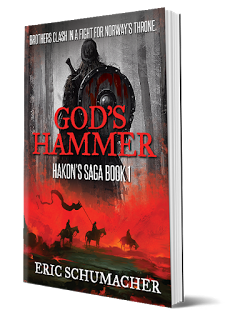 History and legend combine in the gripping tale of Hakon Haraldsson, a Christian boy who once fought for the High Seat of a Viking realm.
History and legend combine in the gripping tale of Hakon Haraldsson, a Christian boy who once fought for the High Seat of a Viking realm.It is 935 A.D. and the North is in turmoil. King Harald Fairhair has died, leaving the High Seat of the realm to his murderous son, Erik Bloodaxe. To solidify his claim, Erik ruthlessly disposes of all claimants to his throne, save one: his youngest brother Hakon.
Erik's surviving enemies send a ship to Wessex, where the Christian King Athelstan is raising Hakon. Unable to avoid his fate, he returns to the Viking North to face his brother and claim his birthright, only to discover that victory will demand sacrifices beyond his wildest nightmares.
Only 0.99 on Kindle (19th - 20th April) Amazon UK only.
Amazon US Amazon UK
Raven’s Feast
It is 935 A.D. and Hakon Haraldsson has just wrested the High Seat of the North from
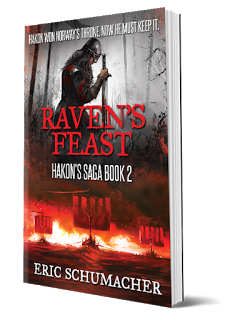 his ruthless brother, Erik Bloodaxe. Now, he must fight to keep it.
his ruthless brother, Erik Bloodaxe. Now, he must fight to keep it.The land-hungry Danes are pressing from the south to test Hakon before he can solidify his rule. In the east, the Uplanders are making their own plans to seize the throne. It does not help that Hakon is committed to his dream of Christianizing his people - a dream his countrymen do not share and will fight to resist.
As his enemies move in and his realm begins to crumble, Hakon and his band of oath-sworn warriors must make a stand in Raven’s Feast, the riveting sequel to God’s Hammer.
Amazon US Amazon UK
Published on April 17, 2018 23:00
April 16, 2018
King Arthur, Merlin, and the Prophecy of the Six Kings by Anne O’Brien #Arthurian #History @anne_obrien
King Arthur, Merlin, and the Prophecy of the Six Kings.By Anne O’Brien
Where does this intriguing prophecy come from?
It is said that King Arthur asked Merlin this question:
'What will be the adventures of the last rulers of this Kingdom, and how will this Kingdom end?'
This Prophecy of the Six Kings is said to be Merlin's reply to Arthur.

The true origins of this prophecy are very much under a cloud. It is thought to have was written down in the year approximately 1312, at the time of the birth of King Edward III. It was certainly the most popular prophecy of the 14th century when men conjectured about the coming years.
The six kings who would follow King John were, according to Merlin, likened to six beasts. Henry III a lamb out of Winchester with a white tongueEdward I a dragonEdward II a goatEdward III a bearRichard II a lambHenry IV a moldewarpe (mole) cursed of God's mouth
As Edward III's reign progressed, the accuracy of the prophesy seemed to be confirmed. Spain would tremble, the bear would sharpen its teeth on the gates of Paris, the bear would regain all the lands of his ancestors, and more. With Edward as King of England, all seemed to happen as was foretold. Spain was defeated in a naval battle, Edward's major successes against the French at Crecy and Poitiers need no further explanation. Thus in a superstitious age many accepted the prophecy as a framework for God's plan for the English monarchy. But although in Edward III's reign all was glory and achievement, Englishmen might begin look at the rest of the prophecy with some foreboding.

Edward III would be followed by a lamb. Hardly the Black Prince who had shown less than lamb-like characteristics in his military career on the field of Crecy and Poitiers and in his campaign in Castile. It would certainly be a more fitting description for his ten-year-old son Richard II.
Here the prophesy falls in a convoluted style which is difficult to interpret with events of Richard's reign. Within a year this lamb would build a great city. But then there would be a civil war and the lamb would lose part of his kingdom to a hideous wolf. Eventually he would recover his lands and give them to an eagle who would govern well in the King's name until overcome by pride At this point the eagle would be murdered by his brother and the lamb (Richard) would die, leaving his lands once more at peace. He would be succeeded by the next king, a mole under whose rule the kingdom would be wrenched apart and plunged again into civil war between three warring factions.
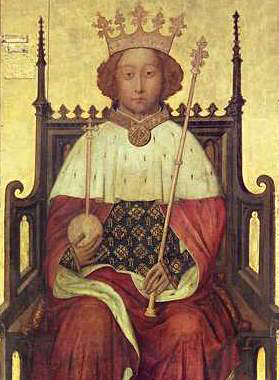
Merlin's prophecy for Richard's reign with its idea of an eagle and a wolf taking part is less than clear when matched with actual events. On the other hand Richard's death and Henry IV's succession is clear enough, as well as the period of civil war which followed Henry's accession.
The sixth king after King John - Henry IV - would be a 'moldewarp', Merlin had said, with a rough skin like a goat. Henry might well consider this to be true for himself, when he was struck down by a severe skin complaint. It was described as leprosy, and although this is now thought to be unlikely, Henry certainly suffered from some skin disease, which again would help to give credence to the whole prophecy.
Early in Henry's reign, so Merlin said:
A dragon shall rise up in the north which shall be full fierce and shall move war against the 'moldewarp' and shall give him battle upon a stone. This dragon shall gather again into his company a wolf that shall come out of the west that shall begin war against the moldewarp on his side, and so shall the dragon and he bind their tails together. Then shall come a lion of of Ireland that shall fall in company with them, and then shall England tremble ... the moldewarp shall flee for dread and the dragon, the lion and the wolf shall drive him away ... and the land shall be partitioned in three parts; to the wolf to the dragon and to to the lion, and so it shall be for evermore.
Can we see this in the history of the reign? Who were the dragon, the lion and the wolf? We can indeed recognise this vicious trio. The Earl of Northumberland was the dragon. Sir Edmund Mortimer was the lion out of Ireland. Owain Glyn Dwr was the wolf from the west, out of Wales.Together these three men made the Tripartite Indenture, to oust Henry and divide England between them. Merlin said that England would be called the Land of Conquest.
Historically, the dragon, lion and wolf were unsuccessful in overcoming Henry. They were defeated and Henry held on to his throne. Nor did Henry die from drowning in a flood as Merlin predicted, his descendents becoming homeless in a strange land. Henry's descendant was the famous warrior King Henry V who kept a firm hold of his crown, although the same can not be said of his son Henry VI who fell foul of the vicissitudes of the Wars of the Roses. But this does not detract in any way from the magical nature of Merlin's prophecy, and the fact that medieval men might look for its fulfilment. We cannot wonder that both Richard and Henry felt the pressure of ancient prophecies on their shoulders.

What should not surprise us is that the drama and mysticism surrounding King Arthur and Merlin was as keenly sought in medieval times as it is today. The stories of the chivalric knights, layered with courage and death, with betrayal and supernatural power, continue to appeal, and I expect they always will.
Anne O’Brien
 Anne O’Brien was born in West Yorkshire. After gaining a BA Honours degree in History at Manchester University and a Master’s in Education at Hull, she lived in East Yorkshire for many years as a teacher of history.
Anne O’Brien was born in West Yorkshire. After gaining a BA Honours degree in History at Manchester University and a Master’s in Education at Hull, she lived in East Yorkshire for many years as a teacher of history.She now lives with her husband in an eighteenth-century timber-framed cottage in the depths of the Welsh Marches in Herefordshire, on the borders between England and Wales, where she writes historical novels. The perfect place in which to bring medieval women back to life.
Anne loves to hear from readers, you can find her: Website Facebook Twitter
The Queen of the North
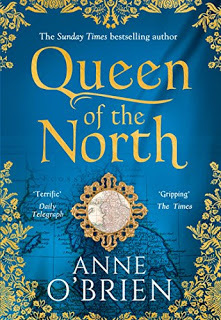 To those around her she was a loyal subject.In her heart she was a traitor.
To those around her she was a loyal subject.In her heart she was a traitor.1399: England’s crown is under threat. King Richard II holds onto his power by an ever-weakening thread, with exiled Henry of Lancaster back to reclaim his place on the throne.
For Elizabeth Mortimer, there is only one rightful King – her eight-year-old nephew, Edmund. Only he can guarantee her fortunes, and protect her family’s rule over the precious Northern lands bordering Scotland.But many, including Elizabeth’s husband, do not want another child-King. Elizabeth must hide her true ambitions in Court, and go against her husband’s wishes to help build a rebel army.
To question her loyalty to the King places Elizabeth in the shadow of the axe.
To concede would curdle her Plantagenet blood.
This is one woman’s quest to turn history on its head.
Available for Pre-Order
Released 31st May 2018
Amazon
Published on April 16, 2018 23:00
April 15, 2018
Unearthing the First American Witch Hanging Case by Beth M Caruso #History #America @oneofwindsor
Unearthing the First American Witch Hanging Case by Beth M Caruso
 Alse Young was hanged at the Meeting House Square in Hartford, Connecticut, on what is now the site of the Old State House (pictured)
Alse Young was hanged at the Meeting House Square in Hartford, Connecticut, on what is now the site of the Old State House (pictured)Few people have ever heard of Alice ‘Alse’ Young, the first witch-hanging victim in the American colonies. The fact that ten others were also hanged in Connecticut years before the Salem witch trials is also largely unknown. My novel One of Windsor: The Untold Story of America’s First Witch Hanging aims to raise awareness about this ignored history as well as entertain the reader with an enthralling story that includes love, passion, fear, revenge, survival, and sisterhood. It is a combination of real history mixed with literary invention.
From the moment I first learned about Alice Young, my mind reeled in desperate ways to understand why such an important historical figure had vanished from the record. Certainly, the energy leading up to such a dramatic and decisive event would have been intense and peppered with many raw emotions, especially fear. Part of the reason that Alice Young disappeared from known history was that documents concerning her witchcraft case ceased to exist even though many other court records the days before and days after her hanging are accounted for. The looming question is could this be a cover-up? There are only two direct records that pertain to her. The first is a brief description written in 1647 by the governor and early founder of Massachusetts, John Winthrop. He noted “One_ (blank)___Of Windsor arraigned and executed at Hartford for a witch”. Again, more questions arise. Did the governor know her name or did he omit it on purpose? Over two hundred years would pass before a young man discovered an old book in the wreckage of an ancient Windsor, Connecticut home. That book rescued out of rubble, the old Windsor Church Record, now called The Matthew Grant Diary, was the key to discovering the name of the first witch-hanging victim. Fortunately, the diary made it into the hands of historian James Hammond Trumbull who discovered, a notation on the inside cover. Matthew Grant had written simply, “May 26, ‘47 Alse Young was hanged.” Later his daughter Annie Trumbull shared this discovery with the public in a Hartford Courant article in 1904 and later donated The Matthew Grant Diary to the Connecticut State Library. Despite such little evidence, I was determined to find Alice somewhere and capture her elusive story. Luckily, I knew of an old map that plotted out the old properties of ancient Windsor. On a street called Backer Row that no longer exists, lived a man name John Young who many historians presumed to be the husband of Alice Young. Since I couldn’t find information about Alice directly, I delved into the lives of every other family living on Backer Row in 1647, the year of her hanging. With the help of old land records from the town of Windsor, genealogical records, and many other historical documents, I was able to recreate the map for Backer Row specific to 1647. The pattern of people that came to life before me on Backer Row amazed me and provided many important clues. A possible story and theory quickly emerged about her identity and the possible reasons for her hanging. What astonished me the most was that the story was hidden only by the fact that the women, the wives of the men on Backer Row, were largely ignored, as so often happens in early American history.
Writing about Alice was a rich and interesting experience. The words seemed to flow and filling in the narrative came more easily than I ever expected. From the beginning, I wanted to convey that Alice Young was not just a victim of an unjust witchcraft accusation, but she was also a human being with a full life who was dearly loved and tragically lost. With heartfelt effort, I wrote One of Windsor to lovingly find Alice Young again and bring her story back into view. For she is a part of American history that is vibrant, dramatic, and often tragic—part of a history that must never be forgotten.
Beth M. Caruso
 Author Beth M. Caruso grew up in Cincinnati, Ohio and spent her childhood writing puppet shows and witches’ cookbooks. She received a Bachelor’s degree in interested in French Literature and Hispanic Studies, receiving a Bachelor of Arts from the University of Cincinnati. She later obtained Masters degrees in Nursing and Public Health.
Author Beth M. Caruso grew up in Cincinnati, Ohio and spent her childhood writing puppet shows and witches’ cookbooks. She received a Bachelor’s degree in interested in French Literature and Hispanic Studies, receiving a Bachelor of Arts from the University of Cincinnati. She later obtained Masters degrees in Nursing and Public Health.Working as a Peace Corps volunteer in Thailand, she helped to improve the public health of local Karen hill tribes. She also had the privilege to care for hundreds of babies and their mothers as a labor and delivery nurse. Largely influenced by an apprenticeship with herbalist and wildcrafter, Will Endres, in North Carolina, she surrounds herself with plants through gardening and native species conservation.
Her latest passion is to discover and convey important stories of women in American history. One of Windsor is her debut novel. She lives in New England with her awesome husband, amazing children, loyal puppy, and cuddly cats.
One of Windsor: The Untold Story of America’s First Witch Hanging
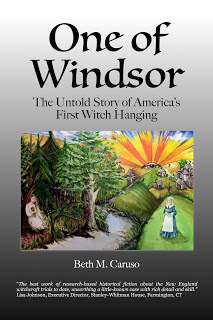 Alice, a young woman prone to intuitive insights and loyalty to the only family she has ever known, leaves England for the rigid colony of the Massachusetts Bay in 1635 in hopes of reuniting with them again. Finally settling in Windsor, Connecticut, she encounters the rich American wilderness and its inhabitants, her own healing abilities, and the blinding fears of Puritan leaders which collide and set the stage for America’s first witch hanging, her own, on May 26, 1647.
Alice, a young woman prone to intuitive insights and loyalty to the only family she has ever known, leaves England for the rigid colony of the Massachusetts Bay in 1635 in hopes of reuniting with them again. Finally settling in Windsor, Connecticut, she encounters the rich American wilderness and its inhabitants, her own healing abilities, and the blinding fears of Puritan leaders which collide and set the stage for America’s first witch hanging, her own, on May 26, 1647.This event and Alice’s ties to her beloved family are catalysts that influence Connecticut’s Governor John Winthrop Jr. to halt witchcraft hangings in much later years.
Paradoxically, these same ties and the memory of the incidents that led to her accusation become a secret and destructive force behind Cotton Mather’s written commentary on the Salem witch trials of 1692, provoking further witchcraft hysteria in Massachusetts forty-five years after her death.
The author uses extensive historical research combined with literary inventions, to bring forth a shocking and passionate narrative theory explaining this tragic and important episode in American history and in the life of Alice ‘Alse’ Young, America's first witch hanging victim.
Amazon US Amazon UK
Published on April 15, 2018 23:00
#BookReview : Mary - A Tudor Princess by Tony Riches #HistoricalFiction #Tudor #mustread @tonyriches
Mary – Tudor Princessby Tony Riches

From the author of the international best-selling Tudor Trilogy, the true story of the Tudor dynasty continues with the daughter of King Henry VII, sister to King Henry VIII. Mary Tudor watches her elder brother become King of England and wonders what the future holds for her.
Born into great privilege, Mary has beauty and intelligence beyond her years and is the most marriageable princess in Europe. Henry plans to use her marriage to build a powerful alliance against his enemies. Will she dare risk his anger by marrying for love?
Meticulously researched and based on actual events, this 'sequel' follows Mary's story from book three of the Tudor Trilogy and is set during the reign of King Henry VIII.
The Coffee Pot Book Club Review

"I ask you to consent to my choice of husband, if it is God's wish that I outlive King Louis..."
Sister to the newly crowned King Henry VIII, Mary's future is assured. She is destined to marry Prince Charles of Ghent, grandson of Ferdinand II of Aragon. But unbeknown to Henry, Mary harbours a deep longing for Charles Brandon, a young knight of Henry's court. Mary understands her duty and she will marry Prince Charles. But if wishes were horses...
Being a huge fan of Tony Riches' work, I could not wait to get my hands on his latest offering. Mary - Tudor Princess, was everything I expected from Mr Riches and then some.
I was swept away by the grandeur of the English and French courts. And the scheming, manipulation, and the endless currying of favour was forever present.
Mary was a woman in a man's world, but she knew her mind, and she cleverly weaved a promise from her brother that if the worst were to happened she could choose her own husband. And choose him she did. It was a dangerous game Mary and Charles Brandon played. To go against Henry’s orders could have meant certain death. But to deny their love would have been an even great crime.
This book was certainly a compelling read with a host of historical characters that, if you are a fan of the Tudor era, you will already know much about. Seeing the Tudor court through Mary's eyes gave a unique perspective.
A beautiful tale of a princess who knew her own heart and was courageous enough to stand up to a king.
I Highly Recommend.
Amazon US Amazon UK
Tony Riches
 Tony Riches is a full-time author of best-selling historical fiction.He lives in Pembrokeshire, West Wales and is a specialist in the fifteenth century, with a particular interest in the Wars of the Roses and the lives of the early Tudors. For more information about Tony’s other books please visit his websitetonyriches.com and his popular blog, The Writing Desk and find him on Facebookand Twitter @tonyriches.
Tony Riches is a full-time author of best-selling historical fiction.He lives in Pembrokeshire, West Wales and is a specialist in the fifteenth century, with a particular interest in the Wars of the Roses and the lives of the early Tudors. For more information about Tony’s other books please visit his websitetonyriches.com and his popular blog, The Writing Desk and find him on Facebookand Twitter @tonyriches.
Published on April 15, 2018 09:02
April 13, 2018
New Release ~ Healer – The Gift of Dreams (the fifth Tale of Freya) by Sarah Dahl #Vikings #sensual #HistFic @sarahdahl13
Tales of Freya by Sarah Dahl
A collection of sensual short stories set in the Viking Age
In a world of crackling fires and rough landscapes, long winters and bloody raids, the immediacy of life and death ignites undeniable passions. Warriors and monks, healers and housewives -- all follow the call of their hearts and bodies to indulge in pleasures that may forever change their lives.
Healer – The Gift of Dreams (the fifth Tale of Freya)
 Viking farmer Magnus is plagued by a demon. Since his wife’s death, the dreaded Mara tortures his body and mind. Powerless, he sends for a healer, the unexpectedly young and beautiful Audr … Are her sensual powers and his unleashed virility enough to banish the demon from his bed?
Viking farmer Magnus is plagued by a demon. Since his wife’s death, the dreaded Mara tortures his body and mind. Powerless, he sends for a healer, the unexpectedly young and beautiful Audr … Are her sensual powers and his unleashed virility enough to banish the demon from his bed?Set in the Viking era, this is a stand-alone, adult read with a HEA.
Excerpt:
"Breathe deeper. Longer."
Magnús wanted to protest, then to try, but something emanated from the tips of the healer‘s fingers that closed off his throat. He felt a hundred years old, but at the same time as helpless as a newborn.
The healer knelt behind him. Audr‘s voice made the little hairs in his neck prickle. "I'll comb your hair, extract the vile spirits that got tangled in there. Too close to you." Her last sentence was a mere whisper, and he shivered.
Too close to him.
He straightened as much as he could. Knives stabbed his back, right above his belt. He almost toppled over and yelped.
Then her hands were there, feeling the shape of his skull and the length of his hair. He felt the teeth of her comb slide into his snarled strands and hoped she wouldn't notice that Alvi hadn't bathed or groomed him lately. The gentle, consistent tugging at his hair was a rare caress and sent goosebumps across his scalp as she stroked from his forehead to where the strands ended below his shoulder blades. Her fingers didn't touch him, but he had to bite his lips in an effort not to shudder with delight. The sensation was magical. So strong it numbed the sharpest stings of pain.
"Does she do it for you?" the healer asked.
"Who?" His voice came out breathless.
"Your slave."
"I can look after myself."
"Not in all respects." Her inoffensive chuckle spoke a deeper truth.
Amazon US Amazon UKGoodreads
Sarah Dahl
 Sarah Dahl lives on the edge of the rural German Eifel and writes historical fiction primarily set in the Viking age. She also works as an editor, translates, and coaches new writers in German and English. She is interested in everyday life in bygone centuries and the human stories that may have occurred behind the hard, historical facts. Her author page is: sarah-dahl.com
Sarah Dahl lives on the edge of the rural German Eifel and writes historical fiction primarily set in the Viking age. She also works as an editor, translates, and coaches new writers in German and English. She is interested in everyday life in bygone centuries and the human stories that may have occurred behind the hard, historical facts. Her author page is: sarah-dahl.com
Published on April 13, 2018 23:00
April 12, 2018
The Gory Tale of Lord Uxbridge’s Leg By Kryssie Fortune #History #NapoleonicWars @KryssieFortune
The Gory Tale of Lord Uxbridge’s Leg
By Kryssie Fortune
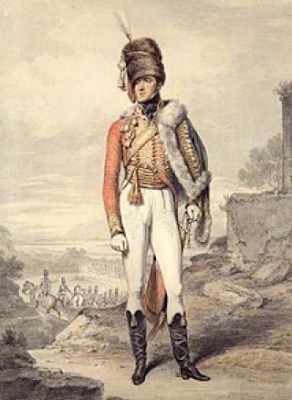
Lord Uxbridge portrayed by Henry Edridge in 1808 before he lost his leg ~ Wikipedia
Lord Uxbridge: “By God, Sir, I’ve lost my leg.”Wellington: “By God, Sir, so you have.”
During the battle of Waterloo, Lord Uxbridge commanded the allied cavalry and 44 guns of the horse artillery. Eight horses were shot from under him in the conflict. In the dying moments of the battle, a cannon shot hit his right leg.
Did he panic?
Did he complain?
No, he turned to Wellington, all stiff upper lip and sangfroid. “By God, Sir, I’ve lost my leg.”
The remains of his leg needed amputating below the knee. Dr. John Hume operated in the house of M. Paris in the village of Waterloo.
There was no antiseptic or anaesthetic. Uxbridge’s only comment: -
“The knives seem somewhat blunt.”
Five days after the battle, the Prince Regent created Uxbridge Marquess of Anglesey and made him a Knight Grand Cross of the Order of the Bath.
BUT
His leg took on a life of its own. M. Paris buried the leg in his garden. Soon visitors arrived, making it a shrine. First, they’d view the blood covered chair where Uxbridge had sat, then they’d visit the leg’s grave.
The tombstone read:
Here lies the Leg of the illustrious and valiant Earl Uxbridge, Lieutenant-General of His Britannic Majesty, Commander in Chief of the English, Belgian and Dutch cavalry, wounded on the 18 June 1815 at the memorable battle of Waterloo, who, by his heroism, assisted in the triumph of the cause of mankind, gloriously decided by the resounding victory of the said day.
However, someone added:
Here lies the Marquis of Anglesey's limb;The Devil will have the remainder of him.
The King of Prussia and the Prince of Orange were among the visitors to the gory exhibit.
In 1878, Uxbridge’s son visited the site. He discovered the bone wasn’t buried but on public display. Horrified, he demanded the return of the bone to England. The Paris family refused to give them up and demanded he buy it from them.
The Belgium Ministry of Justice intervened and ordered the bones reburied. When the last M. Paris died, his widow found the bones in his study along with documents proving their origin.
Fearing a scandal, she burned everything.
After a successful military career and stint as Lord Lieutenant of Ireland, Uxbridge died in 1854. His leg outlasted him by 56 years.
* * * *
Why my interest in the blood and gore of Waterloo?I’ve written a dark Regency Romance set in and around Brussels at the time of Waterloo. Part of the story involves a brief retelling of the battle by soldiers injured in it.
Wickedly Used
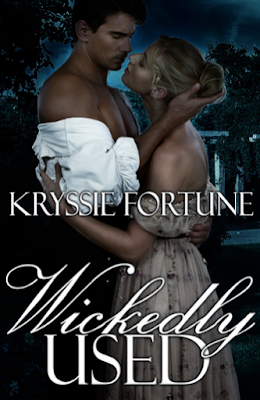
While he is no stranger to pleasurable company from ladies of the night, Major Richard Rothbury of the royal dragoons is not the kind of man who will stand idly by as a woman is taken against her will, and when he witnesses a disreputable cad attempting to force himself on a girl in a back alley, he does not hesitate to intervene.
But after the grateful young woman offers herself to Rothbury, he is shocked to discover that not only was she no harlot, she was a maiden and he has deflowered her. Furious at the girl’s scandalous behavior and her carelessness with her own safety, Rothbury chastises her soundly.
Though she is due to inherit one of the largest fortunes in England, the fact that she cannot touch the money until she marries or turns thirty has kept Elizabeth completely at the mercy of her cruel uncle, and for years she has been treated as if she were a servant. Her encounter with Lord Rothbury is by far the most exciting thing that has ever happened to her, but while he shows great concern for her safety, he refuses to believe that she is anything more than a serving girl.
Despite having made it clear that he doesn’t consider a match between them to be possible, when Elizabeth disobeys him Rothbury proves more than ready to strip her bare, punish her harshly, and then enjoy her beautiful body in the most shameful of ways. But can she dare to hope that he will one day make her his wife, or is she destined to spend her life being wickedly used?
Publisher’s Note: Wickedly Used: A Dark Regency Romance includes spankings and sexual scenes. If such material offends you, please don’t buy this book.
Amazon USA Amazon UK Amazon Canada Amazon Australia
Kryssie Fortune
 Kryssie Fortune writes the sort of hot sexy books she loves to read. If she can sneak a dragon into her paranormal books she will. Her paranormal heroes are muscular werewolves, arrogant Fae, or BDSM loving dragons.
Kryssie Fortune writes the sort of hot sexy books she loves to read. If she can sneak a dragon into her paranormal books she will. Her paranormal heroes are muscular werewolves, arrogant Fae, or BDSM loving dragons.Kryssie likes her contemporary heroes ex-military and dominant. Her heroines are kick ass females who can hold their own against whatever life - or Kryssie - throws at them.
Kryssie's pet hates are unhappy endings, and a series that end on a cliff hanger.
Her books are all stand alone even when part of series. Plot always comes before sex, but when her heroines and heroes get together, the sex is explosive and explicit. One review called it downright sensual.
Kryssie loves to hear from readers, you can find her: Website Blog Twitter Facebook Pinterest Goodreads Amazon Author Page
Published on April 12, 2018 23:00
The Coffee Pot Book Club
The Coffee Pot Book Club (formally Myths, Legends, Books, and Coffee Pots) was founded in 2015. Our goal was to create a platform that would help Historical Fiction, Historical Romance and Historical
The Coffee Pot Book Club (formally Myths, Legends, Books, and Coffee Pots) was founded in 2015. Our goal was to create a platform that would help Historical Fiction, Historical Romance and Historical Fantasy authors promote their books and find that sometimes elusive audience. The Coffee Pot Book Club soon became the place for readers to meet new authors (both traditionally published and independently) and discover their fabulous books.
...more
...more
- Mary Anne Yarde's profile
- 159 followers



